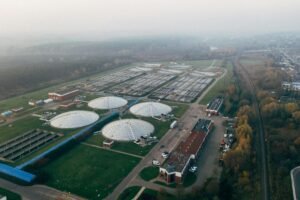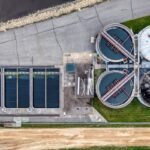Contents
ToggleSewage Treatment Plant (STP)
A Sewage Treatment Plant (STP) is a vital infrastructure component in modern society, designed to purify wastewater by removing harmful contaminants and pollutants. This process transforms raw sewage into a less harmful effluent, suitable for safe discharge or even reuse, thus protecting water resources and safeguarding public health.
Key Considerations in STP Design and Operation
- Site Selection and Planning:
- Strategic Location: Selecting an appropriate site is crucial. Factors to consider include proximity to the wastewater source, accessibility for maintenance, and distance from densely populated areas to minimize potential odor and health hazards.
- Optimized Layout: A well-planned layout is essential for efficient wastewater flow through the treatment process. This includes consideration for future expansion and the integration of sludge management facilities.
- Design and Construction:
- Essential Components: STPs typically incorporate a series of treatment units, including:
- Screens: To remove large debris like plastics and rags.
- Grit Chambers: To remove heavy materials such as sand and gravel.
- Sedimentation Tanks: To allow solid particles to settle from the wastewater.
- Aeration Tanks: To facilitate the breakdown of organic matter through biological processes.
- Clarifiers: To further remove suspended solids after biological treatment.
- Disinfection Units: To eliminate harmful pathogens, often using chlorine or ultraviolet (UV) radiation.
- Material Selection: The choice of construction materials is critical. Durable and corrosion-resistant materials such as concrete, steel, and PVC are commonly used to ensure the longevity and safety of the treatment plant.
- Operational Excellence:
- Routine Monitoring: Regular inspections and maintenance are essential for optimal performance. This includes cleaning equipment, conducting repairs, and adjusting chemical dosages as needed.
- Data Management: Accurate record-keeping of operational data and maintenance activities is crucial for compliance, troubleshooting, and future improvements.
- Skilled Workforce: Trained operators are vital to ensure the efficient and safe operation of the STP.
- Sludge Management:
- Sludge Treatment: Effective sludge management is essential and typically includes processes such as thickening, dewatering, and additional treatments. These steps aim to minimize the sludge volume and ready it for either safe disposal or repurposing, such as its use as fertilizer. Proper handling contributes significantly to the sustainability of the built environment.
- Testing and Commissioning:
- Rigorous Testing: Once constructed, the STP undergoes a series of rigorous performance tests to ensure it meets design specifications and regulatory requirements. These tests typically include:
- Flow Tests: To measure the rate of wastewater flow.
- Biochemical Oxygen Demand (BOD) Tests: To assess the level of organic pollutants.
- Total Suspended Solids (TSS) Tests: To measure the amount of suspended matter in the wastewater.
- pH Tests: To evaluate the acidity or alkalinity of the water.
- Dissolved Oxygen (DO) Tests: To ensure adequate oxygen levels for biological treatment.
- Chlorine Residual Tests: To verify the effectiveness of disinfection processes.
Types of Treatment and Equipment
-
Preliminary Treatment: Removes large debris and grit.
-
Primary Treatment: Removes settleable solids through sedimentation.
-
Secondary Treatment: Utilizes biological processes for break down the organic matter.
-
Tertiary Treatment: Further purifies the effluent through processes like filtration and disinfection.
-
Common Equipment:
- Bar Screens: Remove large debris.
- Grit Chambers: Remove sand and gravel.
- Sedimentation Tanks: Settle out suspended solids.
- Aeration Tanks: Facilitate biological treatment.
- Clarifiers: Remove suspended solids after biological treatment.
- Sand Filters: Further remove suspended solids.
- Disinfection Units: Utilize chlorine or UV radiation.
- Sludge Handling Equipment: Includes sludge thickeners, dewatering presses, and drying beds.
Pumping Systems
- Centrifugal Pumps: Commonly used for transferring wastewater and treated effluent.
- Positive Displacement Pumps: Suitable for handling thick sludge.
- Submersible Pumps: Used to lift wastewater from lower levels.
- Air-Operated Diaphragm Pumps: Used for pumping sludge and adding chemicals.
Water Quality Standards and Testing
- Regulatory Compliance: Treated effluent must meet specific water quality standards before discharge or reuse.
- Key Parameters:
- pH
- Biological Oxygen Demand (BOD)
- Chemical Oxygen Demand (COD)
- Total Dissolved Solids (TDS)
- Total Suspended Solids (TSS)
- Coliform Bacteria Count
Conclusion
Sewage Treatment Plants play a critical role in environmental protection and public health. By effectively treating wastewater, STPs contribute to the sustainability of water resources and the overall well-being of communities. Continued advancements in technology and a commitment to best practices in design, operation, and maintenance are essential to ensure the continued effectiveness of these vital infrastructure components.












